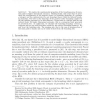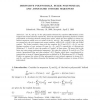72 search results - page 7 / 15 » combinatorics 1999 |
89
Voted
COMBINATORICS
1999
15 years 7 days ago
1999
We show how to count tilings of Aztec diamonds and hexagons with defects using determinants. In several cases these determinants can be evaluated in closed form. In particular, we...
118
Voted
COMBINATORICS
1999
15 years 7 days ago
1999
We find, in the form of a continued fraction, the generating function for the number of (132)-avoiding permutations that have a given number of (123) patterns, and show how to ext...
81
Voted
COMBINATORICS
1999
15 years 7 days ago
1999
Let m and n be positive integers, and let R = (r1, . . . , rm) and S = (s1, . . . , sn) be non-negative integral vectors. Let A(R, S) be the set of all m
98
Voted
CORR
1999
Springer
15 years 7 days ago
1999
Springer
ABSTRACT. We explore the combinatorial properties of the branching areas of execution paths in higher dimensional automata. Mathematically, this means that we investigate the combi...
86
Voted
COMBINATORICS
1999
15 years 7 days ago
1999
Let Pn and Qn be the polynomials obtained by repeated differentiation of the tangent and secant functions respectively. From the exponential generating functions of these polynomia...


